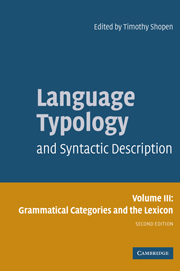Book contents
- Frontmatter
- Contents
- List of figures
- List of tables
- List of contributors
- Acknowledgements
- List of abbreviations and symbols
- 1 Typological distinctions in word-formation
- 2 Lexical typologies
- 3 Inflectional morphology
- 4 Gender and noun classes
- 5 Aspect, tense, mood
- 6 Lexical nominalization
- Bibliography
- Language index
- Subject index
2 - Lexical typologies
Published online by Cambridge University Press: 29 December 2009
- Frontmatter
- Contents
- List of figures
- List of tables
- List of contributors
- Acknowledgements
- List of abbreviations and symbols
- 1 Typological distinctions in word-formation
- 2 Lexical typologies
- 3 Inflectional morphology
- 4 Gender and noun classes
- 5 Aspect, tense, mood
- 6 Lexical nominalization
- Bibliography
- Language index
- Subject index
Summary
Introduction
This chapter addresses the systematic relations in language between meaning and surface expression. Our approach to this has several aspects. First, we assume we can isolate elements separately within the domain of meaning and within the domain of surface expression. These are semantic elements like ‘Motion’, ‘Path’, ‘Figure’, ‘Ground’, ‘Manner’, and ‘Cause’, and surface elements like ‘verb’, ‘adposition’, ‘subordinate clause’, and what we will characterize as ‘satellite’. Second, we examine which semantic elements are expressed by which surface elements. This relationship is largely not one-to-one. A combination of semantic elements can be expressed by a single surface element, or a single semantic element by a combination of surface elements. Or again, semantic elements of different types can be expressed by the same type of surface element, as well as the same type by several different ones. We find here a range of typological patterns and universal principles.
We do not look at every case of semantic-to-surface association, but only at ones that constitute a pervasive pattern, either within a language or across languages. Our particular concern is to understand how such patterns compare across languages. That is, for a particular semantic domain, we ask if languages exhibit a wide variety of patterns, a comparatively small number of patterns (a typology), or a single pattern (a universal). We will be interested primarily in the last two cases, as well as in the case where a pattern appears in no languages (universal exclusion).
- Type
- Chapter
- Information
- Language Typology and Syntactic Description , pp. 66 - 168Publisher: Cambridge University PressPrint publication year: 2007
- 50
- Cited by



